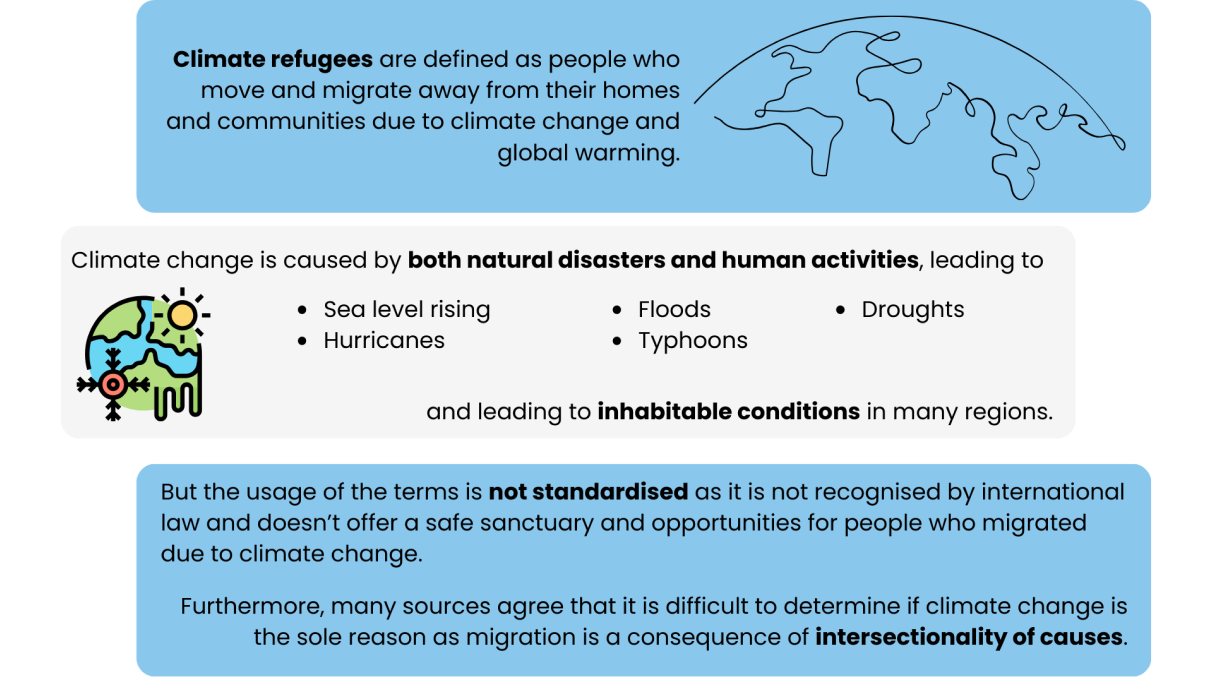BY @ANAGA SIVARAMAKRISHNAN | 5 MIN READ | PUBLISHED ON 3.1.2024
Reimagining the Collective Wisdom of Climate Change and Migration with Apurva
The relationship between climate change and migration has influenced many to move, in the hope of better opportunities. But migrating to a new place isn’t the answer every time. Over the years, with the increasing importance placed on climate change and its impact, many have started working towards defining problems and designing suitable solutions.

What do we know about climate change and migration?
Opportunities or instabilities in economic, environmental, socio-cultural and political factors influence
people to migrate. Sources highlight that people mostly migrate internally (within the country), moving
towards urban areas for better livelihood, education and infrastructure. Though an adaptive measure that
offers a new life to many, migration does weigh heavily on the host communities and regions. Sources list
that these regions see socio-economic disruption, increase in unemployment, and large informal settlements.
There is a sudden increase in consumption of resources, leading to insufficient education, healthcare and
housing infrastructure and environmental impact, especially pollution.
These reports also provide potential solutions to improve the resilience of these populations and to tackle the impact of migration, such as climate change mitigation, sustainable practices across domains, responsible use of resources, disaster preparedness and improved infrastructure, especially for vulnerable populations. The issue of climate change is deep and wide, pervading into various domains and impacting globally, calling for multi-national interventions. There is a great emphasis on different actors like governments, NGOs, research centres, markets and change leaders to play their part in knowledge generation, designing solutions and approaches, policy-making, raising awareness across levels and building accountability with each other to follow through on their promised actions.
The sources and reports referred also highlight how poor data, especially quantitative data, on climate migration leads to incorrect assessment if climate is a crucial factor influencing the move. The lack of relevant and recent data makes it difficult to trace migration patterns caused by climate change. This gap in data can be tackled through updated migration registries and databases that can be accessed globally to trace migration patterns, prepare and build resilience against climate change. These registries can also be utilised to tackle problems beyond the intersection of climate change and migration.
With the gist of the problems and potential solutions in place, what else can be done to untie the knots of this problem? Building an infrastructure of collective wisdom, the most essential part of designing solutions which encourage the sharing of knowledge and collaborations between different actors, regions and countries, to tackle challenges of climate change and migration. COP28, hosted by the United Nations at the beginning of the month, is a wonderful example of collective wisdom, where different domains and sectors came together to assess and act on the global trajectory of climate change.
Collaboration leads to the emergence of collective wisdom, which covers a wide range of topics, themes and information. Collective wisdom offers multifaceted perspectives, designing long-term sustainable solutions, eventually leading to integrating them into public policy and holistic governance structures. The knowledge shared can be used to build on each other, to understand the problem statements and feasible solutions across different regions and demographics. The collective wisdom curated can help to trace emerging trends across geographies and time as well as understand any gaps in knowledge generation.
So, how do we collaborate our collective wisdom?
The increasing role of digital tools in recent years contributes to not only building collective wisdom but
to also collecting and analysing data. It is easier to track the movement of people from various sources,
tracing patterns and identifying areas for intervention. Using digital tools also aid in reducing challenges
with accessing and collecting data on migration and its connection to climate change.
Let us reimagine how perceiving this problem would change if we placed collective wisdom at the centre, where expertise and experience from diverse backgrounds and perspectives meet together to share and redesign solutions. Working at the nexus of social development, technology and collective wisdom, in Apurva.ai, there is immense potential to view climate change and migration.
Experimenting with Apurva
Having had to look up resources to write this piece, I was constantly surprised by the immense amount of
information available. Focusing on painting an inclusive picture across intersections and actors, this
seemed like the perfect opportunity to experiment with the emergence of collective wisdom with Apurva. Below
is a sample of how Apurva reimagines climate change and migration when information available online are put
together.

Apurva.ai was able to go beyond reimagination and identify emerging patterns across sources like the increasing intensity and frequency of climate change impacts, and the need for holistic approaches, inclusion of regional institutions and shifting to proactive approaches to tackle the issue at hand. On the other hand, Apurva.ai was also able to point out blindspots present in the knowledge curated like poor economic considerations, gender dimensions, socio-cultural factors, conflict and political instability and ethical considerations. This helps to put together a comprehensive outlook from different pockets of knowledge.
At Apurva.ai, the power of collective wisdom is enhanced by relevant and credible data, resulting in important insights, analysis, reframing and reimagination of the world, problem statements and potential solutions. The above is just a glimpse of meagre open sources online. This opens new avenues to understanding this intersection of climate change and migration across regions, thereby effectively addressing data gaps globally. It is mind-boggling to comprehend what more can be done with different actors like governments, NGOs, change leaders and research institutes working together by bringing in their perspectives, experience and expertise, contributing continuously to collective wisdom and refining approaches and solutions.
References
- Boudreau, D., McDaniel, M., Sprout, E., and Turgeon, A. (2023). Environmental Refugee. National Geographic. https://education.nationalgeographic.org/resource/environmental-refugee/
- Clement, V., Rigaud, K. K., de Sherbinin, A., Jones, B., Adamo, S., Schewe, J., Sadiq, N., & Shabahat, E. (2021). Groundswell. Acting on Internal Climate Migration. Part II. Washington, DC: The World Bank. Online: https://doi. org/10, 1596, 36248.
- Henley, J. (2020, September 09). Climate crisis could displace 1.2bn people by 2050, report warns. The Guardian. https://www.theguardian.com/environment/2020/sep/09/climate-crisis-could-displace-12bn-people-by-2050-report-warns
- Huckstep, S. and Clemens, M. (2023). Climate Change and Migration: An Overview for Policymakers and Development Practitioners. Center for Global Development. https://www.cgdev.org/publication/climate-change-and-migration-overview-policymakers-and-development-practitioners
- Internal Displacement Monitoring Centre. (2017). Global Report on Internal
- Displacement.https://www.internal-displacement.org/global-report/grid2017/#download.
- International Organization for Migration. (2008). Migration and Climate Change.
- IPCC. (2023). IPCC, 2023: Climate Change 2023: Synthesis Report, Summary for Policymakers. Contribution of Working Groups I, II and III to the Sixth Assessment Report of the Intergovernmental Panel on Climate Change [Core Writing Team, H. Lee and J. Romero (eds.)]. IPCC, Geneva, Switzerland. DoI: 10.59327/IPCC/AR6-9789291691647.
- Randall, A. (n.d.). Climate Refugees definition: can we define a climate refugee?. Climate and Migration Coalition. https://climatemigration.org.uk/climate-refugees-definition/
- Randall, A. (n.d.). Climate refugee statistics: how many, where and when?. Climate and Migration Coalition. https://climatemigration.org.uk/climate-refugee-statistics/
- The World Bank. (2021, September 13). Climate Change Could Force 216 Million People to Migrate Within Their Own Countries by 2050 [Press Release]. https://www.worldbank.org/en/news/press-release/2021/09/13/climate-change-could-force-216-million-people-to-migrate-within-their-own-countries-by-2050
- UNHCR. (2019). Climate change and displacement. https://www.unhcr.org/news/stories/climate-change-and-displacement
- UNHCR. (2020). How climate change is multiplying risks for displacement. https://www.unhcr.org/news/stories/how-climate-change-multiplying-risks-displacement
- UNHCR. (2023). Climate change and displacement: the myths and the facts.https://www.unhcr.org/news/stories/climate-change-and-displacement-myths-and-facts
